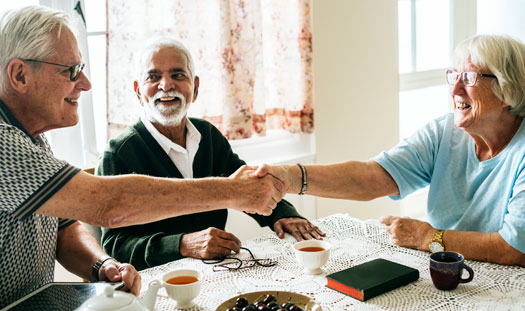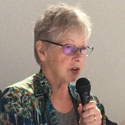Connecting with Others—Why That’s So Important

May is Older Americans Month. The national theme is Connect, Create, Contribute. I encourage you to reach out to an older person—a friend, family member, neighbor, colleague, or client—and spend even a couple minutes asking about their lives and experiences. If you can connect on a periodic basis, even better.
Let’s focus on the first “C”—Connect. Connections. Several Aging and Disability Services staff members attended the American Society on Aging’s 2019 Aging in America Conference last month. They observed a growing interest in the issues of social isolation and loneliness among researchers and service providers alike. Studies have shown that a large percentage of older people in the United States have reported feelings of loneliness—anywhere from 20 percent to 43 percent of those studied—while 17 percent are socially isolated. These are significant numbers!
We can’t always know which comes first—loneliness or social isolation. Either one can cause the other. We cannot assume that someone who is surrounded by family, friends, and community doesn’t feel lonely. Nor can we assume that someone who is usually alone feels lonely. But it makes sense that someone who is socially isolated may feel lonely and people who feel lonely may end up in social isolation.
A researcher named Julianne Holt-Lunstad compared mortality rates across both social connection and health indicators and found that loneliness was more damaging to our health than smoking cigarettes on a daily basis.
We also know that people who feel lonely are at increased risk of dementia, diabetes, cardiovascular disease, disability, and early death. We know that people who are socially isolated are at increased risk of cardiovascular disease, infections, hypertension, and premature cognitive decline. But health care providers do not routinely and systematically assess patients for loneliness and isolation.
Whether it’s because health care providers don’t address social isolation, or people who live in social isolation or experience loneliness are less inclined to seek care, or they are more likely to use a skilled nursing facility, people who are socially isolated end up costing Medicare considerably more money, to the tune of $6.7 billion annually. AARP now calls social isolation “a silent killer” (as we have often heard hypertension described) and a significant public health issue. Take a moment to read “Medicare Spends More on Socially Isolated Older Adults” (AARP Public Policy Institute, November 2017).
The World Health Organization includes social exclusion as a social determinant of health—conditions in which people are born, grow, live, work, and age. They included social participation in The 8 Domains of Livability, which the AARP Network of AARP Network of Age-Friendly States and Communities adopted, and on which our own Age Friendly Seattle built its action plan.
From a policy perspective, AARP has recommended use of the Welcome to Medicare and Annual Wellness Visits to identify people who are socially isolated and connect people to evidence-based interventions. Public health departments can develop and disseminate messages to help overcome stigma some people experience with loneliness. There is nothing wrong with letting someone know you are lonely.
We are all at risk. Loneliness can occur even if you live with others and have friends. Addressing loneliness is every bit as important as other health risks. And each of us can take steps to maintain a social network—for ourselves and for others.
Speaking of connections, in Seattle-King County, you can call Community Living Connections (1-844-348-5464) to get answers to questions about aging, disability, caregiving, and more. If you or someone you know is experiencing loneliness, or you want to find opportunities to connect with others, you can ask about resources. Your call and consultation are free, and so are referrals and many services.
I also encourage you to talk with your health care provider, even if you are not experiencing and have not experienced loneliness or social isolation. Let them know these are public health issues that concern you, and you hope they are assessing all older patients’ risk.
Following are some strategies for building your social network:
- Chronic Disease Self-Management Program—this evidence-based program helps people with conditions such as arthritis, diabetes, hypertension, pain, and lung disease, which can cause some people to avoid social interaction, to learn new skills and tools to manage their health and stay active, in the company of others with similar experiences (even the instructors). You can find contact names and numbers here.
- Community meals—Aging and Disability Services funds congregate meals at about 50 sites throughout King County, including ethnic-specific meals. Some offer nutrition education and fitness activities, too.
- Exercise programs—contact your nearest senior center or Parks Department and you’ll find a wealth of opportunities for people of all abilities (from chair exercise to distance walkers to Senior Games competitors).
- Faith communities—many places of worship offer social activities for older people and for all ages, as well as a range of other services. You can find hundreds of faith communities in an online directory maintained by the Church Council of Greater Seattle.
- Falls prevention programs—similar to programs listed above, you can join with older adults to learn how to prevent falls, which can be very isolating if they result in a broken bone (or worse). For more information, e-mail Mary Pat O’Leary, who promotes falls prevention for Aging and Disability Services, or Alan Abe, the One Step Ahead coordinator at Public Health—Seattle & King County.
- Neighborhood organizations—get to know more people in your neighborhood by attending meetings and activities close to home. In Seattle, contact the Seattle Department of Neighborhoods to learn more. Elsewhere, call King County 2-1-1 to ask about organizations in your zip code.
- Follow your passion—what do you love to do that you could do with other people? Chances are, there’s a MeetUp group for that!
- Volunteer—chances are, there’s something you can easily do that can help others. An excellent online source of volunteer opportunities is VolunteerMatch.org. Or take advantage of excellent one-on-one guidance and support by volunteering through RSVP—the Retired & Senior Volunteer Program—operated by Solid Ground.
Back to Older Americans Month—yes! Connect, Create, Contribute! Reach out to someone else. Your connection will create good will and contribute to your greater good.
 Contributor Ava Frisinger chairs the Seattle-King County Advisory Council on Aging & Disability Services, which publishes AgeWise King County. She welcomes input from readers via e-mail (advisorychair@agewisekingcounty.org) as well as applicants for open positions on the council. For more information, visit www.agingkingcounty.org/advisory-council.
Contributor Ava Frisinger chairs the Seattle-King County Advisory Council on Aging & Disability Services, which publishes AgeWise King County. She welcomes input from readers via e-mail (advisorychair@agewisekingcounty.org) as well as applicants for open positions on the council. For more information, visit www.agingkingcounty.org/advisory-council.

Mark Your Calendars
Following are some of the events that Advisory Council members will participate in this month and next:
- Saturday, May 4 (all day): Neighbor Day—the Seattle Department of Neighborhoods encourages all residents to indulge in random acts of kindness in your neighborhood.
- Friday, May 10 (12–2 p.m.): ADS Advisory Council, Seattle Municipal Tower 4050/4060
- Thursday, May 16 (10–11 a.m.): Age Friendly Seattle Coffee Hour with Seattle Department of Neighborhoods director Andrés Mantilla, Central Building (710 3rd Ave)
- Friday, May 17 (9–11 a.m.): Age Friendly Coalition for Seattle and King County steering committee (e-mail agefriendly@seattle.gov for location)
- Friday, May 17 (2 p.m.): Mayor’s Council on African American Elders, Seattle Municipal Tower 4090
For more local Aging Network events, click here.
![AgeWise King County [logo]](https://www.agewisekingcounty.org/wp-content/themes/agewisekingcounty/images/logo.png)